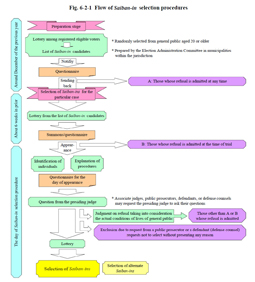| Previous Next Index Image Index Year Selection | |
|
|
1 Summary of Saiban-in system Cases to be covered by Saiban-in trials are, in principle, cases pertaining to offenses punishable by death penalty, life imprisonment with or without work (Item-1 cases), and cases to be treated within the collegiate court system which pertains to offenses causing death to victims through intentional criminal activities (Item-2 cases), all of which are major offenses of great interest to the general public. In order to avoid imposing a considerable burden on Saiban-ins, however, certain cases may be excluded wherein there is a possibility of harm imposed on them or their families because of the defendant's behavior, claims concerning the organization to which the defendant belongs, behavior of members of those organizations, actual harm being imposed or threats of such, or other such circumstances and, as a result, Saiban-ins may be unable to perform their duties out of fear. Cases not included in the scope of coverage may be covered by the Saiban-in system when consolidated with cases that are within the scope of coverage. When cases covered by Saiban-in trials are prosecuted, they shall all be brought to pretrial conference procedure prior to the first trial date. The court will clarify the main points of the case, determine the evidence to be examined, and specify the way in which the examination will take place. By establishing concrete trial plans this way, intensive systematic trials can be realized. In addition, expert examinations may be conducted prior to the trial as required. Fig. 6-2-1 shows the flow of selecting Saiban-ins. Fig. 6-2-1 Flow of Saiban-in selection procedures A list of Saiban-in candidates selected by lottery from those registered as eligible voters shall be made every year by respective district courts. Saiban-in candidates are then again selected by lottery from the list of Saiban-in candidates for respective cases and summoned to the court for the selection procedure. The courts select Saiban-ins after excluding those with certain reasons for disqualification, those out of occupational limitation, those with reasons deemed disqualifiable for the case, those whose refusal is allowed by the court due to certain reasons, and those whom the public prosecutor or the defendant requests not to be selected without presenting any cause. The procedure of selecting Saiban-ins is closed to the public.Alternate Saiban-ins may be selected when deemed necessary taking into consideration the period of the trial and other circumstances. In the case there is a shortage in number of Saiban-ins, alternate Saiban-ins can be designated to fill the vacancy. Daily allowances and travel expenses, etc. are paid to those appearing at courts as Saiban-ins, alternate Saiban-ins, or Saiban-in candidates. At Saiban-in trials deliberation shall be conducted by a collegial body consisting of three judges and six Saiban-ins (for cases without dispute that meet certain conditions one judge and four Saiban-ins) to find the facts pertaining to a judgment of guilty or not guilty, etc., and to decide the application of acts and regulations and appropriate punishment. Verdicts shall be made based on the opinions of the majority of the collegial body including those of both the judges and the Saiban-ins. Saiban-ins may question defendants or witnesses, etc. regarding matters necessary in making judgments through informing the presiding judge they wish to do so. Construction of acts and ordinances and judgment on criminal proceedings, etc. may only be made by the judges and the results then provided to Saiban-ins. Saiban-ins shall follow those decisions. |
